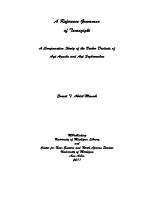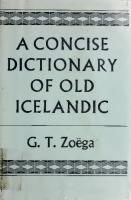A Comparative Dictionary of Gypsy Dialects in Hungary. A magyarországi cigány nyelvjárások szótára 9639147303 [PDF]
147 35 30MB
English, Hungarian Pages 230 Year 2000
Papiere empfehlen
![A Comparative Dictionary of Gypsy Dialects in Hungary. A magyarországi cigány nyelvjárások szótára
9639147303 [PDF]](https://vdoc.tips/img/200x200/a-comparative-dictionary-of-gypsy-dialects-in-hungary-a-magyarorszagi-cigany-nyelvjarasok-szotara-9639147303.jpg)
- Author / Uploaded
- József Vekerdi
Datei wird geladen, bitte warten...
Zitiervorschau
MC 137.122
#
> « \ *
^
4« w
jozsef vsKínoi
GYPSy-ENGUSH-HUNGAKMN VICTIONAKf Win ENGLISH TO GYPSY AND HUNGÁRIÁN TO GYPSY WORD USTS
VEKERDI JÓZSEF
A magyarországi cigány nyelvjárások szótára
Második, javított kiadás Szerkesztette VÁRNAI ZSUZSA
HC13Í.J21
íOci
TEREBESS KIADÓ BUDAPEST, 2000
A Comparative Dictionary of Gypsy Dialects in Hungary by JÓZSEF V E K E R D I
Second revised edition with the assistance of ZSUZSA VÁRNAI
TEREBESS PUBLICATIONS BUDAPEST 2000
© József Vekerdi 2001 Covcr design: Béla Tettamanti Technical editor: Kristóf Bozzay Terebess Hungary Ltd. Corvin utca 13. H-n65 Budapest Fax: (+36-1)403-6218 E-mail: [email protected] http://www.tercbess.hu ISBN 963 9147 30 3 TE 75 Printed in Hungary
Preface According to a sample survey carried out in 1971, 71% of the 320,000 Gypsies then living in Hungary spoke only Hungárián, 21% Hungárián and Romani, and 8% Hungárián and Rumanian. There are no Gypsies in Hungary wlio speak only Romani. The Hungarian-Romani biiingual group is divided intő five Gypsy dialects, or ratlier languages: 1. The overwheiming majority speak Viax dialects, primarily Lovari. Practicaiiy identicai to Lovári are the Másári and Drizári subdialects spoken by a limited number of families. Siight grammatical (and very few lexical) divergences differentiate the Colári and Kherári subdialects from Lovári (the speakers of these subdialects are few in number). Speakers of Lovári live eveiywhere in the country. The Lovári dialect uses many Rumanias loan-words (about 160 out of the complete stock of ca. 800 primary words). 2. The Gurvári (called alsó Cerhári or Maskar) dialect is ciosely linked lexically with Vlax owing to the fact that many words (esp. loan-words from Rumanian) were borrowed from Lovári by the Guvári group. This refers particularly to the Cerhári subdialect spoken in North-Eastern Hungary, where the Lovári and Cerhári population live together. Another subdialect of Gurvári is spoken in Central Hungary (this subdialect was less influenced by Lovári). Although the Gurvári dialect differs from Vlax in grammar, the lexical affinity makes Lovári more or less comprehensible to speakers of the Cerhári subdialect (this is not so vice versa: Lovári speakers do not understand Gurvári). 3. The Hungárián Gypsy dialect (Romungro) par excellence, formerly spoken all over the country, has become almost totally extinct. The Romungro group had given up Romani at the end of the 19th century and now most of their descendants speak only Hungárián. Practicaiiy speaking, they represent the monolingual Hungarian-speaking group (71 %) in this country. Only a few thousand persons in North Hungary continue to speak this dialect of Romani in addition to a few families in SouthWest Hungary. Three subdialects are distinguished by siight phonetical differences (vowei length). There are no Rumanian loans in this dialect whiie there are a limited number borrowed form Serbian. Speakers of Romungro and Vlax do not under stand each other's tongue at all.
4. A variant form of tlie Hungárián Gypsy dialect is tlie Vend Gypsy dialect, spoken sporadicaiiy in Soutii-West Hungary. Tiie difference is mainiy lexicai: there are Germán, Croatian, and Slovenian loans in Vend wiiicii are uni achel, chel -> achel. If no dialect is indicated, the given word is used in all dialects in the same form, e.g. dad father. If there are etymologicaily different words expressing the same notion in the particular languages, they figure in separate
entries wliile refereiices to the individiial entries are given in brackets: ablaka G (fejastra V, bloka R, bloko Ve,fenstra S) 'window'. fejástra V (ablaka G, bloka R, bloko Ve,feiistra S) 'window'. Irregiilar forms of flexión foiiow tiie heading in brackets, e.g.: achel... (praet. acliija, achja, aslahi R, áclnno Ve...) Indián etymologies are given according to R. L. Turner: A comparative dictionary of the Indo-Aryan languages, London 1966.. Hungárián and Germán etymologies are referred to merely by anda. fadaringal Cs from this direc- axtonpéko somnakuuo V G pure gold // színarany. tion // innen. adáthar —> athar. aj V ah // ej. addig V G R (zo lang S aj ke V lo // nicsak. kana. tadjiki NSz (us. kattji V) so ákárkon whoever // akárki many // annyi. le. ölo V G R pigsty, hen hoiise // ÓKH. 5n -^ ünk. ondja / oddja R, ödja Ve, odja G {kothe V, köti doti S) there, in that direction // oda; ~ géja I gélo he went there // odament; ~ del gives it to him // odaaad. jondjal V Szt to groan // nyög ? önk -> ünk. onk chlnel Ve slam to earth // földhözvág. ono duj —> uno duj. topica V NSz ape // majom. opral V G adv., praep. 1. (Jón pral S) from above // felül ről; ~ tele avilas he came down from above // leszállt fentről. 2. (pral S) over, abo ve // fent, felett; ~ amende above us // fölöttünk; - o kher over the house // a ház fölött; ~ si I hin it is above // fent van; dikhes les khote ~? do you see him there above? // látod odafent? opre V G (iipre 1.2. R, pré S) 1. prev. up // fel [see under
120 the respective verbs // id. az egyes igéknél] üstjei ~ gets up // felkel; zal ~ po kast climbs a tree // felmászik a fára. 2. adv. up there, high // fent; ~ andel felhövuri high in the clouds // fent, a felhők között; ~ si be awake // fent van, ébren van; pasljol inosa lies on his back // ha nyatt fekszik. opruno V, upruno R, uprüno I uprútno Ve, praltüno S 1. upper, higher // felső. 2. Ve chief, main // fő. oráfeder Ve farther on // ar rébb. örde / orde R V, örde Ve (us. akörde, kathe V) here, in this direction // ide, erre; ov ~! come here // gyere ide; sun ~ listen to me! // ide hall gass! ostólo Ve (mesalji V, kafidi R, astala G krujal. trupo V G R (syn. testo









